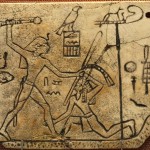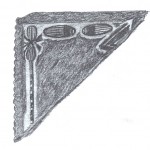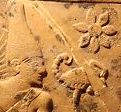
The Origin and Early Development of the Smiting Scene
The depiction of the king with mace raised above a helpless prisoner is one of the most prominent and enduring images of ancient Egypt. Although it has often been claimed that the origin for this iconic image lies in the Predynastic Era, this is unlikely. Not until the Narmer Palette do we see a possible model for dynastic developments of the image. These developments are traced here within the Early Dynastic Period [more…]
Edition - April, 2013

The goddess Neith in the Early Dynastic period
The goddess Neith was one of Egypt’s oldest deities, very well documented from the Early Dynastic period, when Egypt was first brought together as a unified country. She is very familiar from later periods, particularly in the New Kingdom and Third Intermediate periods (figure 1). Over the millennia she was endowed with numerous attributes: a creation goddess, a sky goddess, a protector of the king (with Isis, Nephthy and Serket), protector of one of the Four Sons of Horus, the mother of Sobek, and the consort of Seth, occasionally associated with snake, cow and pig. So where did this great deity come from? The earliest evidence to allow the formation of a coherent picture is Early Dynastic. [more…]

Merneith – The First Queen of Egypt?
Merneith: The First Queen of Egypt? With considerable attention lavished upon the Eighteenth Dynasty, popular TV documentaries, and with a much-visited Mortuary Temple at Deir el-Bahri, many people are aware that the female ruler Hatshepsut reigned as “King” and Pharaoh during the New Kingdom. Many people also know that Queen Cleopatra (Cleopatra VII Philopator) ruled […] [more…]

Who Is King Scorpion?
Abstract
The ‘Scorpion’ Mace-head is one of the most significant objects from the main deposit at Hierakonpolis. Unlike the Narmer Mace-head, it is not a complete mace-head but only part of one. Apart from the dominant figure after whom the palette is named, the surrounding scenes are partial; however excellently these have been conserved. This makes the object even more enigmatic and difficult to interpret than usual in the context of the development of Early Dynastic royal iconography. [more…]
This article re-examines the evidence and suggests an alternative identification for King Scorpion. [more…]
Edition - September, 2011
Book Review: History of Ancient Egypt: Neolithic Period ot the Early Dynastic Period including Menes, Narmer, Hieroglyphs, Thinis and More.
By Andrea Byrnes. Published on Egyptological, 9th September 2011 History of Ancient Egypt: Neolithic Period ot the Early Dynastic Period including Menes, Narmer, Hieroglyphs, Thinis and More. Edited by Grace Windsor ISBN 9-781241314675 This is a self-published book, one in a series about Ancient Egypt, widely available on online book stores. Before I […] [more…]
 By
By